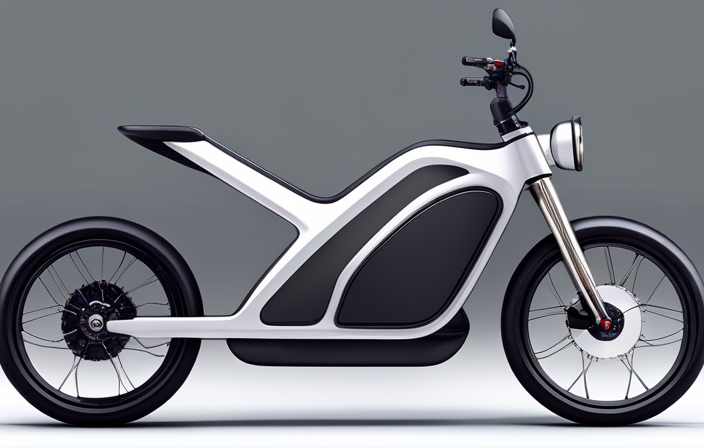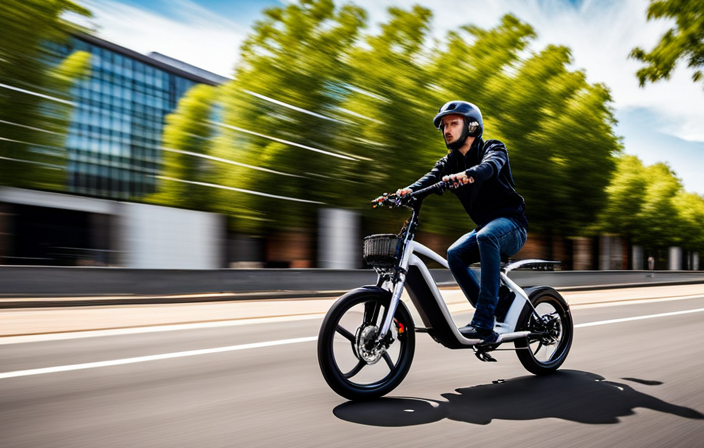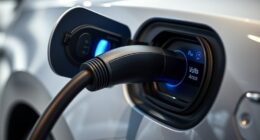Are you prepared to construct your own electric bicycle? Picture yourself gliding effortlessly and efficiently through the streets, all thanks to your own handiwork.
In this article, we will guide you through the step-by-step process of constructing an electric bike that perfectly fits your needs and preferences. From selecting the right frame and components to assembling the wiring and testing the electric system, we’ve got you covered.
Get ready to embark on an electrifying journey as you bring your dream bike to life!
Key Takeaways
- Choose a bike with a sturdy frame and suitable components for conversion to an electric bike
- Install a motor and battery system that is compatible with the bike’s frame and design
- Ensure proper wiring and connections for safe and efficient operation of the electric bike
- Test ride the electric bike and make any necessary adjustments for optimal performance and comfort
Determine Your Needs and Preferences
Before you can start building your electric bike, it’s important to determine your needs and preferences.
Begin by considering the purpose of your electric bike. Will you be using it for daily commuting, off-road adventures, or leisurely rides?
Next, think about the terrain you will be riding on. Will you be tackling steep hills or mostly flat surfaces? This will help you determine the power and torque requirements of your electric bike.
Additionally, consider the distance you will be traveling on a single charge. If you plan on longer rides, you may need a higher capacity battery.
Lastly, think about your riding style and comfort preferences. Do you prefer a more upright or aggressive riding position?
Choose the Right Frame and Components
When selecting the frame and components, it’s important to consider factors such as durability and compatibility. To ensure a successful construction of your electric bike, follow these four steps:
-
Choose a frame: Look for a frame that is sturdy and lightweight, preferably made of aluminum or carbon fiber. This will provide the necessary strength while keeping the overall weight of the bike manageable.
-
Select the drivetrain: Opt for high-quality components such as derailleurs, cranksets, and cassette. Consider the number of gears you need and the type of riding you’ll be doing to determine the appropriate drivetrain setup.
-
Decide on the brakes: Electric bikes require reliable braking systems. Disc brakes, both mechanical and hydraulic, offer excellent stopping power and are preferred over rim brakes for their better performance in wet conditions.
-
Don’t forget the wheels: Choose wheels that are strong and durable, capable of handling the additional weight of the motor and battery. Look for rims made of aluminum or carbon fiber and high-quality spokes.
Now that you have selected the frame and components, it’s time to move on to the next step: choosing the motor and battery.
Select the Motor and Battery
To select the motor and battery, you should consider factors such as power output, range, and compatibility with your chosen frame and components.
The motor is the heart of your electric bike, providing the power needed to propel you forward. It is important to choose a motor that matches your desired speed and terrain requirements. Factors such as wattage, voltage, and torque should be considered to ensure optimal performance.
Additionally, the battery is crucial for determining the range and duration of your electric bike. Look for a battery with sufficient capacity and voltage to meet your needs.
Ensure that the motor and battery are compatible with your chosen frame and components, as this will ensure a seamless integration.
With the motor and battery selected, you can now move on to gathering the necessary tools and equipment for the construction process.
Gather the Necessary Tools and Equipment
Make sure you have all the tools and equipment you need for the process of assembling your electric bike.
To begin, gather a set of hex keys in various sizes, as these will be used to tighten bolts and screws throughout the assembly. You will also need a pair of pliers for any wire connections that need adjusting.
A torque wrench is essential for properly tightening the motor and battery mounts to the frame. Additionally, have a wire cutter and stripper on hand for any necessary wire modifications.
Finally, don’t forget a set of screwdrivers, both flathead and Phillips, to handle different types of screws.
With all your tools ready, you can now move on to assembling the frame and attaching components.
Assemble the Frame and Attach Components
Start by attaching the frame components together using the provided bolts and screws. This step is crucial in ensuring the stability and structural integrity of your electric bike. Follow the instructions carefully to avoid any mistakes.
Here’s a simple three-step process to guide you:
-
Align the frame pieces: Make sure the frame components are properly aligned before tightening the bolts. This will prevent any misalignment issues later on.
-
Secure with bolts: Insert the bolts into the designated holes and tighten them using a wrench or socket set. Ensure that they are tightened enough to hold the frame together securely, but avoid over-tightening to prevent damage.
-
Attach additional components: Once the frame is assembled, proceed to attach other components such as the handlebars, seat post, and pedals according to the instructions provided.
With the frame assembled, you can now move on to the next section and begin installing the motor and battery.
Install the Motor and Battery
Now that you have assembled the frame and attached the components, it’s time to move on to the next step: installing the motor and battery. This is a crucial part of constructing your electric bike, as it provides the power necessary for propulsion.
To ensure a smooth installation process, refer to the following table for a detailed guide on how to install the motor and battery:
| Step | Procedure | Tools Required |
|---|---|---|
| 1 | Locate the mounting brackets on the frame | Allen wrench |
| 2 | Align the motor with the brackets and secure it using the provided screws | Screwdriver |
| 3 | Connect the motor to the battery using the designated wiring connectors | Wire strippers |
Connect the Wiring and Test the Electric System
Once you’ve successfully installed the motor and battery, it’s time to connect the wiring and test the electric system. This crucial step ensures that your electric bike will function properly and safely.
Here’s what you need to do:
-
Connect the wiring: Begin by identifying the wires from the motor and the battery. Match the corresponding colors and connect them securely using wire connectors or soldering. Make sure to follow the wiring diagram provided by the manufacturer to avoid any mistakes.
-
Test the electric system: Before fully assembling the bike, it’s essential to test the electric system to ensure everything is working correctly. Connect the battery and turn on the power switch. Check if the motor starts smoothly and if the throttle responds accurately. Test the brakes to ensure they engage properly and check the LED display for any error messages.
By following these steps, you’ll be able to confirm that your electric system is functioning reliably.
Now, let’s move on to the next section where we will discuss how to adjust and fine-tune the bike for optimal performance.
Adjust and Fine-tune the Bike
After successfully testing the electric system, it’s time to make adjustments and fine-tune your bike for optimal performance.
Begin by inspecting the chain tension and adjusting it, ensuring it is neither too loose nor too tight.
Next, check the brake pads and adjust them to ensure they make proper contact with the rims and provide efficient braking.
Fine-tune the derailleur by ensuring it shifts smoothly between gears without any skipping or hesitation.
Additionally, adjust the seat height and handlebar position to ensure a comfortable riding posture.
Finally, check the tire pressure and inflate them accordingly for optimal traction and performance.
Once you have completed these adjustments, your bike will be ready for the next crucial step: ensuring safety and legal compliance.
Ensure Safety and Legal Compliance
To ensure safety and legal compliance, it’s important to inspect your bike’s lights and reflectors and ensure they are in working order. Here are three key areas to focus on:
-
Headlights: Check that your bike’s headlights are properly aligned and functioning. They should provide adequate illumination for night rides, helping you see and be seen by others on the road.
-
Taillights: Verify that your bike’s taillights are bright and functioning correctly. These lights are crucial for alerting motorists and other cyclists of your presence from behind, especially in low-light conditions.
-
Reflectors: Ensure that all required reflectors, such as those on the front, rear, pedals, and wheels, are securely attached and reflective. These reflectors enhance your visibility to others, making it easier for them to spot you on the road.
By diligently inspecting and maintaining your bike’s lights and reflectors, you can ride safely and within the legal guidelines.
Now, enjoy your newly constructed electric bike!
Enjoy Your Newly Constructed Electric Bike!
Congratulations on completing the construction of your electric bike! Now it’s time to enjoy the fruits of your labor and experience the thrill of riding your own custom-made electric bike. Before you embark on your first ride, it is important to familiarize yourself with the features and functionalities of your newly constructed electric bike. Refer to the table below for a detailed overview:
| Component | Functionality | Usage Tips |
|---|---|---|
| Battery | Power source | Charge fully before first use |
| Motor | Propulsion | Adjust speed settings according to terrain |
| Controller | Control system | Understand different modes and settings |
| Display Console | Information | Monitor battery level and speed |
Conclusion
Congratulations on completing the construction of your very own electric bike!
You’ve put in the time and effort to carefully choose the right components, assemble them with precision, and ensure the bike meets safety and legal requirements.
Now, it’s time to hit the road and enjoy the thrilling experience of riding your newly constructed electric bike.
So, hop on, feel the wind in your hair, and let the electric power propel you to new adventures.
Embrace the freedom and excitement that awaits you!









